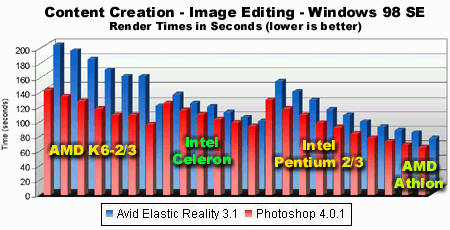Desktop CPU Comparison - September 99
by Anand Lal Shimpi on September 6, 1999 1:23 AM EST- Posted in
- CPUs

Avid's Elastic Reality and Adobe's Photoshop tests are also a part of the SYSmark 98 suite, and although the versions of the applications used aren't the latest, both of them have support only for MMX instructions meaning there is no SSE or 3DNow! bias present in either application.
Elastic Reality is an application similar in function to Kai's Power Goo, for those of you not familiar with either of those two, it allows you to essentially "morph" 2D images together. This "morphing" process is a multi-pass process and eats up quite a bit of memory as well as CPU time. The benchmark greatly benefits from a faster L2 cache versus a slower albeit larger one, therefore all of the K6-2 test systems lagged behind the rest of the competition while the K6-3 450 was only slightly slower than a Celeron 400.
The Celerons took the price to performance ratio win in this case, as they easily came close to outperforming, clock for clock, the Pentium II and III. The faster L2 cache of the Celeron definitely comes in handy here as the Celeron 500 finds itself less than 5 tenths of a second slower than the more expensive Pentium III 500.
The Athlon takes the lead once again, however this time the results are a bit more interesting, instead of the normal 30 - 40% performance increase we're looking to expect from AMD's greatest, the gap is brought down to around 5 - 15% over the fastest Pentium III, the 600. Taking a look at the Photoshop benchmarks also resulted in a similar situation, where the Athlon 600 was only around 5 seconds faster than the Pentium III 600. While neither of these two benchmarks show off the full potential of the Athlon's power, they do make a very important point; although the Athlon is a faster overall processor, the performance increase it will boast over an equivalently clocked Pentium III 600 will vary from one situation to the next, and in some cases, that performance increase may be in the 5 - 15% bracket. Not to condemn AMD's processor, as it is a wonderful piece of hardware, but from the perspective of Intel, a higher clock speed Coppermine could definitely start giving the Athlon a run for its money.
What's going to end up happening is that AMD and Intel will engage in a nice little war based on clock speed, and if Intel doesn't win, they'll resort to a price war to attempt to regain territory lost to the Athlon, let's hope AMD has a little more up their sleeves than a 700MHz Athlon in Q4.
Th rest of the results of the Photoshop benchmark almost completely coincide with the results from the Elastic Reality tests, however with less emphasis placed on faster L2 caches and more placed on raw CPU power, the K6-2 is much more competitive in this test than it was in the last. While it (the K6-2) isn't the fastest in image editing situations, it does get the job done and if the price is right, for some, that's all that matters.










0 Comments
View All Comments